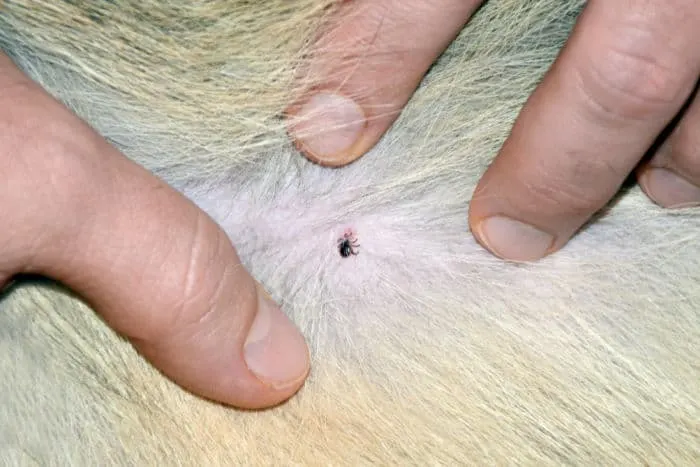Learn what symptoms are associated with canine tick bites and how to protect dogs from exposure. Dogs owners that live in or travel through high-risk areas for ticks should know how to recognize possible exposure and know what to do in case of a bite.

What are Ticks? And What do They Do?
Ticks are small arachnids that are related to mites and spiders. Ticks survive by feeding on blood and securely attaching themselves to their food sources while feeding. Left unattended or untreated, ticks can take several days to finish feeding on one animal. This extended period of contact makes ticks very efficient disease carriers to both humans and animals.
Ticks typically wait for passing food sources by clinging to the tips of shrubs and grasses. When they sense the passing of a warm-blooded creature, they let go of their perch and drop onto the unsuspecting passerby. Ticks cannot jump or fly; crawling is their only means of getting around.
There are many different varieties of ticks. The most well-known is the Deer Tick, which has been known to carry Lyme disease. Other types such as the Brown Dog Tick are very rarely reported to bite humans and tend to focus their attention on small mammals such as dogs.

How to Tell if a Dog Has Been Bitten by a Tick
Initially, the only way to know is to check your dog thoroughly for ticks. Look in areas like their paw pads and inside their ears too. The sooner you get them off, the less chance they have of getting a tick-borne illness from it.
Canine symptoms are fairly similar to the ones that humans experience but can be much harder to spot through the fur of a dog.
Your dog may:
- Shake their head.
- Lick or scratch at a certain spot.
- The skin may be red and inflamed.
Symptoms of Lyme disease in dogs include
- Fever.
- Muscle and joint pain and soreness.
- Rash that spreads outwards from the bite (this would only be noticeable in areas where there is little hair such as the tummy).
- Decreased appetite.
- Lethargy and tiredness.
- Weight loss.
- Neurological signs.
- Swollen lymph nodes.
- Excessive drinking or urination.
- Kidney disease.
- Most dogs are asymptomatic – only 5 to 1o% develop clinical signs.
How soon after being bitten do symptoms appear in dogs?
It can be weeks to months after being bitten.
External: Fleas and Ticks
There are several different species of ticks your dog may be exposed to depending on what part of the US you live in.
Deer ticks are common in the Eastern United States and are known to carry Lyme Disease. In Southern parts of the US, we can see the Lone Star tick that can transmit Ehrlichiosis or Rocky Mountain Spotted Fever.
There are many species not discussed here, but you can see which are in your area by checking out the CDC website: https://www.cdc.gov/ticks/geographic_distribution.html
One of the most common diseases carried by ticks is Lyme Disease. This disease often does not cause clinical signs in most dogs and many are diagnosed based on routine screening.
Dogs that do become symptomatic from Lyme Disease can develop serious complications. Minor signs of the disease include fever and joint pain. A serious complication of Lyme disease is called Lyme Nephritis. This condition can cause injury to the kidneys, leading to kidney failure.
Other common flea and tick-borne diseases are Babesia and Bartonella. Hepatozonosis, Tularemia, Anaplasmosis, and Tick Paralysis. Some of these can cause mild signs of infection, but others are life-threatening. This is why monthly prevention is so important.
How can fleas and ticks be prevented?
Preventatives are key to preventing fleas and ticks from biting our Chis and also to prevent diseases transmitted by them. Discuss options for prevention with your veterinarian. Oral and topical options are available. Most veterinarians will recommend treating your pet year-round, especially if you live in warmer regions.
How to Prevent Tick Bites and Infection
In areas known to be infested with ticks, or any area outside where there are trees and grass around, exposure can be difficult to prevent. However, there are ways to cut down on the risk of tick bites.
Purchase flea and tick repellent, which is commonly available at pet stores and veterinary offices. Follow the usage instructions and be careful to avoid getting the spray on sensitive body parts such as the dog’s eyes and mouth. Reapply as directed to deter ticks.
In high-risk, areas keep dogs on a leash and in the center of the trail to avoid brushing up on tall grasses that may harbor ticks.
Avoid letting dogs run free in tall grassy areas that are prone to tick infestations.
Use monthly flea and tick preventative as prescribed by your veterinarian.
Check your dog immediately after you get home. Many times if you do this quickly, you can remove the tick before it attached to the dog.

What to Do if Dog has Been Bitten
The tick should be removed as soon as possible.
- Use a cotton ball soaked with alcohol to clean the area and put it on the tick. Sometimes this will make them detach from the skin.
- Grasp the tick firmly with a pair of tweezers or tick remover tool and firmly pull it straight out, being careful not to crush or twist the tick.
- Once removed, put the tick in a small container of alcohol in case your vet wants to see it. Not all breeds of ticks cause Lyme disease so identification is important.
- Wash the affected area thoroughly with alcohol.
- Wash your hands.
- Call your vet and see if they want you to bring the dog in. If so, bring the tick in too. Tick bites and the infections they can spread are treatable with a variety of antibiotics, but early detection and removal are critical. Dogs will not be positive for tick borne disease for weeks so most vets will not want you to bring your dog in or treat with antibiotics unless positive for disease and the dog is sick.
- If you are in an area where there aren’t many occurrences of Lyme disease, then most likely the vet will just want you to keep an eye out for any symptoms in your dog for the next several months.
Lyme disease and other tick-borne infections are treatable illnesses when recognized promptly. Keep a close eye on dogs and other family pets to ensure that any tick issues are dealt with as quickly as possible.
Make a Tick Removal Kit
If you and your dog go on outside adventures, make a little tick removal kit to keep on hand.
In it put:
- 2 tiny jars of alcohol: one is to use to wipe your dog’s skin and the other is to put the tick in show your vet.
- A few cotton balls.
- Tweezers or tick remover tool.
- Hand sanitizer for you to clean your hands.
Conclusion
Ticks are nasty little blood suckers and no one likes having to deal with them But most of us will have to at some point or another. I have found a tick several times on myself as well as my kids and my dogs. One of my daughters was treated for Lyme disease.
As much as we all hate them, knowledge is power. Be prepared and know what to do before your dog comes into contact with a tick.
Have you had to deal with ticks on your dog before? Do you have any tips that I may have missed? Leave a comment and let us know!


Paula Simons
DVM
This article has been reviewed, fact-checked, and approved by Dr. Paula Simons DVM. You can read more about her on our About page.

Valerie Manon
Sunday 16th of May 2021
We live on the MS Gulf Coast. My Sister-In-Law lived 2 blocks from us. They found a tick on their dog and poor thing got Lyme Disease from it. Not took long after I found a tick on my dog. Luckily my dog didn't get Lyme Disease, but my Sister-In-Laws doing suffered permanent nerve damage from it. Scared me so bad that I have a Lyme Disease included with their yearly vacinations.
Cathy
Sunday 16th of May 2021
Oh wow, I'm sorry for the dog that got sick. It's good you are being vigilant about ticks with your dog.
Cathy Perez
Saturday 15th of May 2021
Thank you Cathy for this information, I’m going to make up a tick removal kit to keep handy for my littles.
Cathy
Sunday 16th of May 2021
You're welcome Cathy!
Francesca
Friday 14th of May 2021
So glad I found your site! We need a place to go to share our little loved ones! My Chihuahua is a rescue & my 1st dog. He is 10 years old and I groom him every night. I also brush his teeth. He isn't heavy. He is my service dog. He was trained by "Operation At Ease.com.&the American Kennel club. He has a blue ribbon for"CANININE GOOD CITIZEN". He was one of 2 Chihuahuas in the class. So proud of him!
Cathy
Friday 14th of May 2021
Thanks for joining us Francesca! SOunds like you have an awesome little chi!